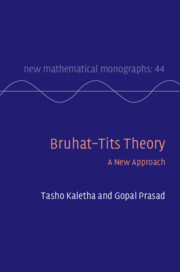Book contents
- Frontmatter
- Dedication
- Contents
- Illustrations
- Tables
- Introduction
- Part One Background and Review
- Part Two Bruhat–Tits Theory
- 3 Examples: Quasi-split Simple Groups of Rank 1
- 4 Overview and Summary of Bruhat–Tits Theory
- 5 Bruhat, Cartan, and Iwasawa Decompositions
- 6 The Apartment
- 7 The Bruhat–Tits Building for a Valuation of the Root Datum
- 8 Integral Models
- 9 Unramified Descent
- Part Three Additional Developments
- Part Four Applications
- Part Five Appendices
- References
- Index of Symbols
- General Index
8 - Integral Models
from Part Two - Bruhat–Tits Theory
Published online by Cambridge University Press: 16 May 2023
- Frontmatter
- Dedication
- Contents
- Illustrations
- Tables
- Introduction
- Part One Background and Review
- Part Two Bruhat–Tits Theory
- 3 Examples: Quasi-split Simple Groups of Rank 1
- 4 Overview and Summary of Bruhat–Tits Theory
- 5 Bruhat, Cartan, and Iwasawa Decompositions
- 6 The Apartment
- 7 The Bruhat–Tits Building for a Valuation of the Root Datum
- 8 Integral Models
- 9 Unramified Descent
- Part Three Additional Developments
- Part Four Applications
- Part Five Appendices
- References
- Index of Symbols
- General Index
Summary
Constructs the integral models of $G$ associated to points of $\cB(G/k)$, or more generally pairs of a point and a concave function. These models are smooth affine $\fo$-group schemes $\sG$ equipped with an isomorphism $\sG \times_\fo k \to G$.
- Type
- Chapter
- Information
- Bruhat–Tits TheoryA New Approach, pp. 283 - 322Publisher: Cambridge University PressPrint publication year: 2023

